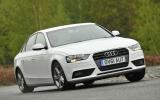The all-new Jaguar XE will have a fierce battle on its hands in the executive car class when the saloon goes on sale in May.
Armed with a new range of fuel-efficient, lightweight Ingenium engines and the latest infotainment technology from Jaguar Land Rover, the XE is expected to be a serious front-runner in the hotly contested class. We run down the Jaguar XE’s chief rivals.
An all-new A4 saloon is due from the German car firm in the second half of this year. The new A4’s dimensions should be close to the current car, with marginal increases to the width and wheelbase to house a new chassis based on the second-generation MLB platform.
The outgoing Audi A4 was dynamically inferior to the BMW 3-series, but the next A4 could be sharper to drive thanks to the MLB platform’s mixture of aluminium, steel and lightweight composite materials, thus reducing the overall kerb weight.
Updated engine technology is planned, featuring cylinder shutdown technology and possibly a plug-in hybrid model, using the same powertrain from the A3 e-tron. Brake energy recuperation and automatic engine stop-start technology should also feature. The latest version of Audi’s MMI infotainment system should also be available, as seen on the new Audi TT.
The outgoing sixth-generation 3 Series is still a consummate performer, having ruled the executive car class since its launch in 2012. However, newly launched rivals have closed the gap significantly and BMW aims to fight back with a facelifted variant this summer.
A new range of turbocharged three-cylinder petrol and diesel engines will join the range, replacing the existing entry-level four-cylinder units. BMW says they will reduce overall kerb weight and increase fuel efficiency by up to 10 per cent.
The facelifted model also gets mild exterior tweaks and an improved interior with new multimedia features.
While the new C-Class is not the most dynamically capable saloon in the segment, it does have a sumptuous, class-leading interior. It’s an area where the Jaguar XE will do well to match, let alone beat.
The engines are highly efficient, too, offering up to 72.4mpg and 102g/km in C200 Bluetec guise. Jaguar claims the base 161bhp 2.0-litre diesel Ingenium motor is capable of 75mpg and CO2 emissions of 99g/km.
The premium Japanese car firm takes a different approach from its key rivals, offering the IS saloon in petrol or petrol-electric hybrid form only. It’s by no means the best in class to drive, but in hybrid form the IS300h is incredibly refined and its ultra-low emissions make it a tempting company car option.
The IS250 petrol lacks the power and flexibility of chief rivals, but some buyers may like its smooth, naturally aspirated delivery.
Read the full Jaguar XE first drive review
Get the latest car news, reviews and galleries from Autocar direct to your inbox every week. Enter your email address below:













Join the debate
Add your comment
Nice looking, It's only when
Exclusive
Really tempted